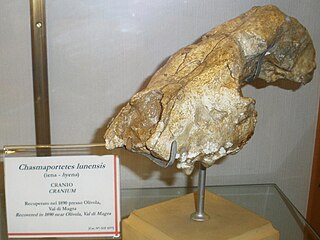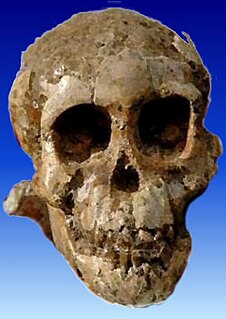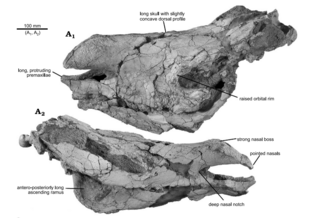
Acinonyx is a genus within the cat family. The only living species of the genus, the cheetah, lives in open grasslands of Africa and Asia.

Diceros is a genus of rhinoceros containing the living black rhinoceros (Diceros bicornis) and at least one extinct species.

Ceratotherium is a genus of the family Rhinocerotidae, consisting of a single extant species, the white rhinoceros, and its extinct relatives, Ceratotherium neumayri and Ceratotherium mauritanicum, of which Ceratotherium efficax is considered a synonym. Another species known as Ceratotherium praecox is now considered a member of the related Diceros.
Metailurini is an extinct taxonomic tribe of large saber-toothed cats that lived in Africa, Asia, Europe, and North America from the Miocene to the Pleistocene.

Aepyceros is a genus of African antelope that contains a single living species, the impala. It is the only known member of the tribe Aepycerotini.

Chasmaporthetes, also known as hunting or running hyena, is an extinct genus of hyenas distributed in Eurasia, North America, and Africa during the Pliocene-Pleistocene epochs, living from 4.9 million to 780,000 years ago, existing for about 4.12 million years. The genus probably arose from Eurasian Miocene hyenas such as Thalassictis or Lycyaena, with C. borissiaki being the oldest known representative. The species C. ossifragus was the only hyena to cross the Bering land bridge into the Americas, and ranged over what is now Arizona and Mexico during Blancan and early Irvingtonian Land Mammal ages, between 5.0 and 1.5 million years ago.
The turnover-pulse hypothesis, formulated by paleontologist Elisabeth Vrba, suggests that major changes to the climate or ecosystem often result in a period of rapid extinction and high turnover of new species across multiple different lineages. Changes may include climate change, tectonic plate shifting, and catastrophes, among other things. It can be seen as an extension of the concept of evolutionary radiation from a single to a multi-clade context.

Selam (DIK-1/1) is the fossilized skull and other skeletal remains of a three-year-old Australopithecus afarensis female hominin, whose bones were first found in Dikika, Ethiopia in 2000 and recovered over the following years. Although she has often been nicknamed Lucy's baby, the specimen has been dated at 3.3 million years ago, approximately 120,000 years older than "Lucy".

Kolpochoerus is an extinct genus of the pig family Suidae related to the modern-day genera Hylochoerus and Potamochoerus. It is believed that most of them inhabited African forests, as opposed to the bushpig and red river hog that inhabit open brush and savannas. There are currently eight recognized species.
Ahl al Oughlam is an archaeological site and palaeontological site located just outside Casablanca, Morocco. It was discovered in 1985 and first excavated in 1989. Ahl al Oughlam is the richest late Neogene vertebrate locality of North Africa. It has also yielded the area's first important carnivore fauna, including 23 taxa, 13 of which are new.

Chilotherium is an extinct genus of rhinoceros endemic to Eurasia during the Miocene through Pliocene living for 13.7—3.4 mya, existing for approximately 10.3 million years.

Ontocetus is an extinct genus of walrus, an aquatic carnivoran of the family Odobenidae, endemic to coastal regions of the southern North Sea and the southeastern coastal regions of the U.S. during the Miocene-Pleistocene. It lived from 13.6 mya—300,000 years ago, existing for approximately 13.3 million years.

Pelagornis is a widespread genus of prehistoric pseudotooth birds. These were probably rather close relatives of either pelicans and storks, or of waterfowl, and are here placed in the order Odontopterygiformes to account for this uncertainty.
Ceratotherium mauritanicum is a species of fossil African rhinoceros found in the Late Pliocene to earliest Holocene of Morocco, Tunisia, and Algeria. Slightly older fossils from the Pliocene of eastern Africa were also proposed to belong to this species, but it has been considered to belong to a somewhat more primitive species, Ceratotherium efficax. A 2020 study considers C. efficax to be the same species as C. mauritanicum, however.
Damalborea is an extinct genus of alcelaphine bovid. It was first named by Alan W. Gentry in 2010, and the type species is Damalborea elisabethae. It is known from the holotype AL 208–7, a skull with horn cores collected from the Middle Pliocene Hadar Formation Member SH-3 of Ethiopia. In addition, a fossils of this or a closely related species were collected from Aramis, Wee-ee and Maka localities in the Middle Awash deposits, lower and upper units of the Laetolil Beds, as well as Tulu Bor Member and an unknown horizon of the Koobi Fora Formation. Geraads, Bobe & Reed (2012) assigned all Damalborea specimens from the Basal Member and Sidi Hakoma member of the Hadar Formation to the species D. elisabethae; in addition, the authors named the second species, Damalborea grayi, described on the basis of fossils from the Denen Dora member of the Hadar Formation. Damalborea was a moderately large alcelaphine with high and narrow skull proportions.
Enhydriodon dikikae is an extinct species in the family Mustelidae that existed during the Miocene and Pliocene epoch. Fossils from this species were discovered in Dikika, Lower Awash Valley in Ethiopia. These fossils were found in the lower basal member of the Hadar Formation, which means they existed more than 3.42 million years ago but the estimated age of the fossils is greater than 3.4 million years old and likely to be closer to 4 million years old. In comparison to the other species in the genus Enhydriodon, E. dikikae is one of the youngest.
Diceros praecox is an extinct species of rhinoceros that lived in Africa during the Pliocene, around 4 million years ago. It is considered the direct ancestor of the living black rhinoceros (Diceros bicornis).

Dolichopithecus is an extinct genus of Old World monkey that lived in Europe during the Late Miocene and Pliocene.

Eoazara xerrii is a species of extinct elasmotheriine rhinoceros from the upper Miocene of Morocco, the first definitive representative of the subfamily in North Africa. It is known from a well preserved skull and postcranial material, preserving the most complete late Miocene rhino skull found in Africa.
Falcontoxodon is an extinct monotypic genus of toxodontid, who lived from the late Pliocene to the Pleistocene in what is now Venezuela. Fossils of this genus have been found in the Chapadmalalan-Uquian Codore Formation, as well as in the more recent Ensenadan San Gregorio Formation.












